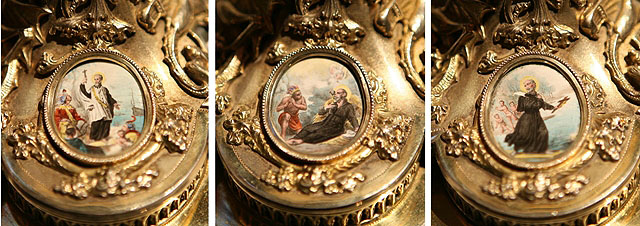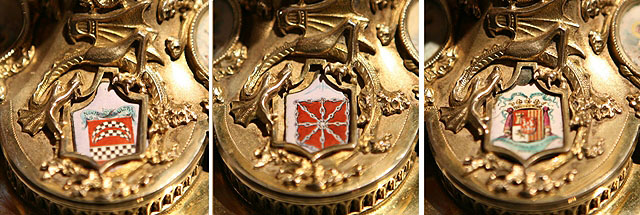Piece of the month of February 2010
CHALICE OF THE CONSECRATION OF THE NEW CHURCH OF SAN FRANCISCO JAVIER (1901) TREASURE. PAMPLONA CATHEDRAL
Eduardo Morales Solchaga
Chairof Navarrese Heritage and Art
Preserved in the treasury of Pamplona Cathedral is a chalice from the beginning of the 20th century, which contains a series of historical conditions that make it shine with its own light in the aforementioned chapel. According to the inscription on the inside of the base: "M. ILLMO Y RVMO. MR. JOSE LOPEZ MENDOZA Y GARCIA BISHOP OF PAMPLONA. MEMORIAL OF THE CONSECRATION AND INAUGURATION OF THE CHURCH DEDICATED TO S FRANCISCO JAVIER. 19TH JUNE 1901. THE DUCHESS VILLAHERMOSA".
It therefore records the consecration of the new church dedicated to San Francisco Javier, which took place on 19 June 1901. It came to replace the chapel that until then had been erected on that site, a process that was part of the restoration of the castle, designed by Ángel Goicoechea y Lizarraga, and financed by the Duchess of Villahermosa. According to certificateof the aforementioned ceremonial, once the consecration of the temple had been completed, "The Exmo. and Illustrious Mr. Juan Soldevila y Romero, Bishop of Tarazona, celebrated pontifical Mass on the newly consecrated altar, with the Holy Sacrifice being attended by the Exmo. Duke of Luna, as royal delegate; the Duchess of Villahermosa, founder; the Bishops of Huesca, Barbastro and Jaca, the Commission of the Cathedral Chapter, the Most Excellent Deputation of Navarre, Commissions of the Town Councils of Pamplona and Sangüesa, many other illustrious gentlemen and an immense concourse of people".
The gilded silver chalice, which has a dual liturgical and commemorative function, was a gift from the Duchess of Villahermosa and Lady of Javier to José López Mendoza y García, bishop of Pamplona between 1899 and 1923, who was responsible for the prior consecration of the church, a ceremony that was absolutely necessary for it to be put into operation. On his death, the chalice was deposited, along with some of his belongings, in the treasury of Pamplona Cathedral, where it has been preserved in an appropriate manner up to the present day, unnoticed among many other ornaments from all over the world subject.
The structure is a neo-Gothic chalice with a hexagonal poly-lobed base with a moulded flange. It has an openwork plinth, with carved lobes and a hexagonal, single-bodied temple gland, supported by cylindrical columns with a flattened apple-shaped knot. The shaft is also hexagonal with a flattened-apple knot with diamond-shaped kisses. As for the cup, it has a flared morphology that differentiates between an openwork and a cut-out sub-cup. It is richly decorated with vegetal and geometric elements superimposed on the base, engraved on the shaft and cut out on the sub-cup. The lobes of the base are framed by oval and rectangular mirrors with different enamels.
Chalice of the consecration of the church of San Francisco Javier (1901)
Despite the lack of any marking, the iconography on the enamels of the foot lobes is of great interest, featuring scenes from the hagiography of the Navarrese saint and heraldic coats of arms. The first of the ovals depicts Saint Francis Xavier preaching, following Gérard Edelinck's model(1682), which in turn was inspired by a painting by Jerome Sourley, active in Lyon in 1664, which no longer exists; The second depicts the death of Saint Francis Xavier, accompanied by an Indian, an iconography that is well known and widespread in many different engraved versions, notably the models by Carlo Maratta and Gaulli. The third depicts the saint's miraculous flight down the river, stalked by the natives with stones and arrows, on a tree trunk, a miraculous event that took place on the Moor's islands. These last two episodes follow faithfully the engravings of the Iconological Life by Fr Gaspar Juárez, although in the second episode the figure of Antonio de Santa Fe, his interpreter in those territories, is omitted.

Enamels with the life of the saint: Saint Francis Xavier preaching, death of Saint Francis Xavier, and miraculous escape of the natives.
As far as heraldry is concerned, three coats of arms are also represented. The first of these, that of the lordship of Javier, cut; the upper register of gules with a crescent checkered in gold and sable; the lower register of silver with a checkered girdle of the same enamels. All this is stamped with the motto "Nihil Ultra" (nothing higher), which according to Julio Altadill is a "clear and appropriate allusion to the supreme sanctity and heroism of our exalted Patron Saint, the highest propagandist of the Catholic faith in the world". The next one depicted is the coat of arms of Navarre, the land of which the saint began to hold the co-patronage, after a long controversy, in 1657. Finally, the coat of arms of the Duchess of Villahermosa is represented, configured on the basis of a half-cut and divided shield: in the first of the registers, a golden castle in gules, clarified in azure; in the second, in silver, a lion rampant in gules, crowned in gold; and in the third, in gold, four gules clubs. Above them, a quarter composed of five arrowheads and three halberd heads on a field of gules. All this is stamped with the ducal crown and is accompanied by two phylacteries: the upper one reads "gloria non moritur, virtus vera nobilitas"; the lower one with the family motto "sanguine empta, sanguine tuebor". The modeltaken is that of the Marquise's "ex libris", probably provided to the goldsmith by the celebrated Don José Ramón Mélida, the Duchess's librarian and chronicler of the celebrations of which an account has been given, among many other tasks.

Enamels with heraldic coats of arms: Lordship of Javier, Kingdom of Navarre and Duchy of Villahermosa
bibliography
- Album of Javier. Recuerdo de la inauguración de la iglesia elevada en honor de San Francisco Javier por la Excma. Sra. Duquesa de Villahermosa, Madrid, Viuda e hijos de M. Tello, 1901.
- FERNÁNDEZ GRACIA, R., El fondo iconográfico del Fondo Schurhammer: la reportde Javier en imágenes, Pamplona, Chairde Patrimonio y Arte Navarro, 2006.
- GOÑI GAZTAMBIDE, J., Historia de los obispos de Pamplona. Siglo XX, Pamplona, EUNSA, 1999, vol. XI.
- TORRES OLLETA, G., Redes iconográficas: San Francisco Javier en la cultura visual del Barroco, Madrid, Iberoamericana, 2009.
- VV.AA., Library Services Javeriana [6 vols.], Pamplona, Fundación Diario de Navarra, 2004 - 2006.
